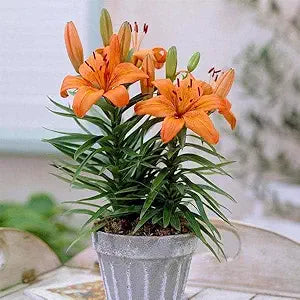Perfume Lily Flower Seeds for Home & Garden
Couldn't load pickup availability
Description
Lily Perfume Seeds (99% Germination, Creepers)
Welcome to bijaseeds, a big, trusted name in the USA seed market with a vast, high-quality selection of non-GMO seeds and heirloom seeds. Our Lily Perfume Seeds offer gardeners an exceptional opportunity to cultivate stunning, fragrant flower seeds that promise a 99% germination rate and vigorous creeping growth. Perfect for beginners and seasoned growers alike, these seeds for planting bring elegance and aroma to any garden space.
Characteristics and Uses of Lily Perfume Plants
The Lily Perfume plant is a captivating addition to any garden, known for its delicate, trumpet-shaped blooms that release a sweet, lingering fragrance. As a creeping variety of lily seeds, it spreads gracefully along the ground or climbs with minimal support, making it ideal for ground cover, trellises, or cascading over walls. These plants typically reach heights of 12-18 inches while sprawling up to 3 feet wide, adorned with lush green foliage and flowers in shades of white, pink, or soft yellow. Beyond their ornamental appeal, they attract pollinators like bees and butterflies, enhancing biodiversity in your garden.
Growing Conditions for Lily Perfume Plants
- Light Requirements: Prefers full sun to partial shade, with at least 6 hours of direct sunlight daily for optimal blooming.
- Soil Preferences: Thrives in well-draining, loamy soil with a pH of 6.0-7.0; enrich with organic matter for best results.
- Temperature Range: Grows best in temperatures between 60-85°F (15-29°C), with tolerance for light frost once established.
Planting Tips for Lily Perfume
- Timing: Sow seeds indoors 6-8 weeks before the last frost or directly outdoors after frost danger passes.
- Depth: Plant seeds ¼ inch deep in moist soil, spacing them 6-12 inches apart to allow for spreading.
- Support: Provide a low trellis or let them creep naturally; gently guide tendrils as they grow.
Watering Instructions and Tips
- Frequency: Water consistently to keep soil evenly moist but not waterlogged, about 1 inch per week.
- Method: Use a soaker hose or water at the base to avoid wetting foliage, reducing disease risk.
- Tips: Mulch around plants to retain moisture and reduce weeds; adjust watering during rainy periods.
Growing Zones
- USDA Zones: Suitable for zones 4-9, with protection needed in colder climates.
- Global Zones: Thrives in temperate regions worldwide, from Mediterranean climates to subtropical areas with mild winters.
Key Benefits & Uses
- High Germination: With a 99% success rate, these seeds ensure reliable growth.
- Fragrance: Fills the air with a delightful perfume, perfect for evening gardens.
- Versatility: Ideal as creeper seeds for ground cover or climbing accents.
Best Uses in the Garden & Landscape
- Garden Beds: Creates a lush, fragrant carpet in flower beds or borders.
- Containers: Spills beautifully over pots or hanging baskets for patios.
- Landscape Design: Enhances sustainable landscapes by covering slopes or framing pathways.
Conclusion
Lily Perfume Seeds from bijaseeds, a big, trusted name in the seed world, offering a wide range of high-quality, non-GMO varieties to gardeners everywhere, bring beauty, fragrance, and ease to your gardening experience. Whether you’re looking to transform a small corner or an expansive landscape, these creepers deliver charm and reliability with every bloom.
FAQ
How do I grow Lily Perfume Seeds?
Start by sowing seeds ¼ inch deep in well-draining soil, either indoors 6-8 weeks before the last frost or outdoors after frost risk. Provide full sun to partial shade, keep soil moist, and space seeds 6-12 inches apart for their creeping habit.
When should I plant Lily Perfume Seeds?
Plant indoors in late winter to early spring (February-March) or directly outdoors in spring after the last frost (April-May), depending on your climate, to ensure strong establishment.
Are Lily Perfume Seeds difficult to grow?
No, they’re beginner-friendly due to their 99% germination rate and adaptability. With basic care—proper light, soil, and water—they thrive easily for gardeners of all levels.







